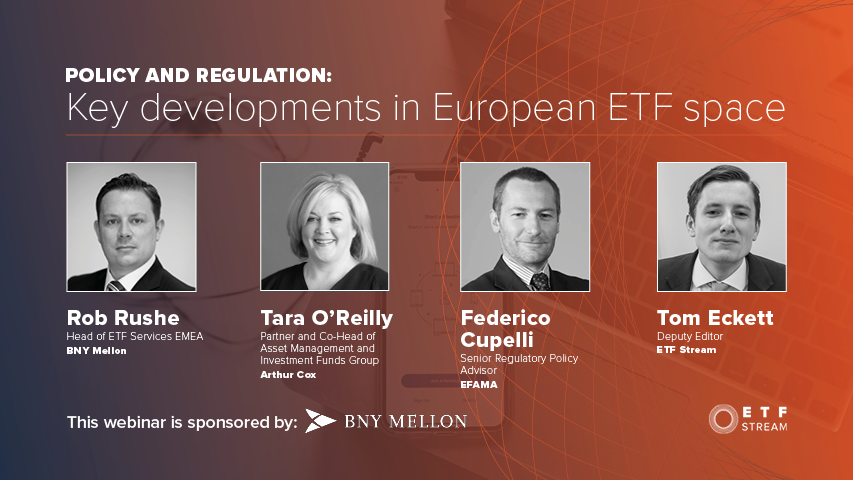The third edition of
ETF Stream’s
webinar series, ETF Ecosystem Unwrapped, reviewed the impact recent policy and regulatory changes have had on the European ETF market as well as any potential changes that could be introduced in the future.
This included discussions around the idea ETFs could cause systemic risk to markets, implementing an ETP classification scheme, the impact of MiFID II, central securities depositories regulation (CSDR) and non-transparent ETFs.
The live discussion started with Rob Rushe, head of ETF services EMEA at BNY Mellon, explaining how ETFs passed another test during the coronavirus volatility.
He added there would always be concerns about the role of authorised participants (APs) due to the fact they operate on a commercial basis however he added there were no signs of them withdrawing from the market during more volatile periods.
“We learn more about the ETF structure during these periods of uncertainty, such as the large spreads seen across bonds,” Rushe said.
“Some would say this is a flawed structure but it shows ETFs are foretelling some of the price challenges in fixed income markets and could be ahead of the game in terms of where the pricing truly is compared to a mutual fund structure.”
Furthermore, Federico Cupelli, senior regulatory policy advisor at EFAMA, supported Rushe’s comments by highlighting that the price discovery role ETFs play has also been more recently recognised by both the Bank of International Settlements and the Bank of England, pointing to a change in tone in the central banking community compared to its long-held view that systemic risks may be lurking beneath the ETF structure
ETP classification
The discussion moved onto the need for an ETP classification scheme but participants warned of the impact this could have on the strength of the UCITS structure.
Tara O’Reilly, partner and co-head of asset management and investment funds group at Arthur Cox, said the classification scheme will be different in the US compared to Europe because of the UCITS system.
“The US classification has drawn out leveraged and inverse funds, but similar products in Europe will have a different profile to those in the US as they are UCITS,” O’Reilly continued.
“If we go down the route of separating products within UCITS, we run the risk of damaging the UCITS brand, which is known for its robust governance.”
MiFID II
One regulation still in its infancy is MiFID II which came in effect at the start of 2018. According to Rushe, one of the biggest challenges associated with MiFID II is the development of a consolidated tape.
“It has been a dream for the European industry over the past 10 years to have a consolidated tape in some way to show the true liquidity of ETFs and enable investors to look at a single source for information with regards to trade execution,” he said.
One unintended consequence of MiFID II is the “drive for visibility has not ended up where we expected it to”, according to O’Reilly. She said there has not been a rush to trade on the major stock exchanges but rather over-the-counter (OTC) trading has moved to electronic platforms.
CSDR
Another regime that is set to come into effect is CSDR. The directive was introduced to improve settlement rates however there are questions over the impact it might have on how authorised participants and market makers manage their inventories, according to Rushe.
With a final implementation period set for February 2021, O’Reilly believed this will be a tough deadline to implement by and Cupelli does not expect regulators will delay further.
“Regulators are not ready to review the extended deadline that has been given unless clear evidence is offered on the relationship between buy ins and the potential higher costs on the end investors,” Cupelli said. “In the extended time remaining, it is important the industry works towards this CSDR requirement to assess their impact.”
Non-transparent ETFs
The final topic of discussion was on non-transparent ETFs and the demand for such products in Europe.
“The European market is much more institutional than retail and we have noticed there has not been a huge demand for non-transparent ETFs, regardless of the regulatory environment,” Rushe commented.
O’Reilly said that from a regulatory perspective, a key issue for regulators is how relevant the public portfolio disclosure is to the proper functioning of the ETF.
“A fundamental principle is that secondary market investors can be ensured that the market price of an ETF is as close as possible to the net asset value (NAV).”
Unanimously, the panellists agree that Europe has not seen any significant demand for non-transparent ETFs and therefore, is not the key priority for regulators at this moment in time.
Sign up to ETF Stream’s weekly email here





